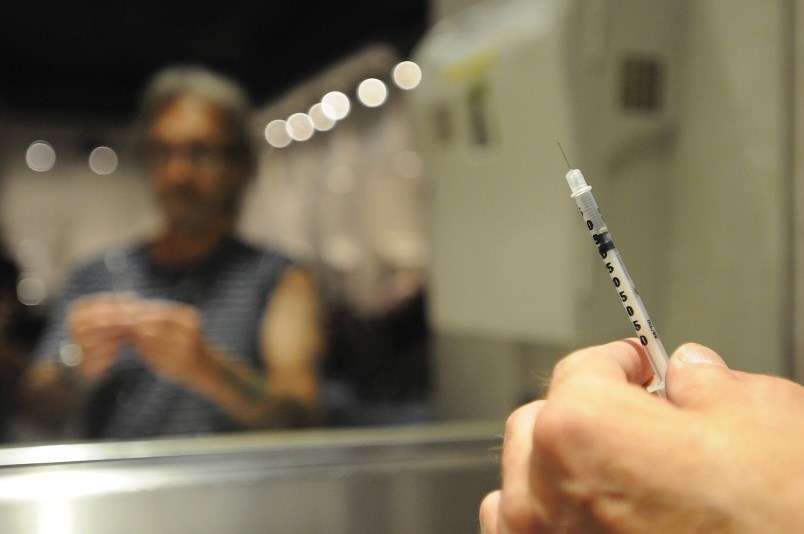Mayor Kennedy Stewart and council unanimously approved a motion Tuesday to request the provincial government contribute at least $3.5 million to help the city tackle the overdose crisis as it stretches into its second year of more than 300 lives lost in Vancouver.
Stewart will now write a letter to Premier John Horgan and Judy Darcy, the Minister of Mental Health and Addictions, to ask for the money, which is the same amount the city generated in 2016 when the previous council approved a property tax increase.
“I do think that more funds are required,” Stewart told reporters after the meeting. “We do have a very finite property tax base here in the city, we can’t shoulder it all ourselves. So I think it’s totally prudent to go forward and ask for additional funding.”
In December 2016, the Vision Vancouver-led administration successfully passed a .5 per cent tax hike—which generated $3.5 million—on top of an originally proposed 3.4 per cent increase. The .5 per cent tax became known as the “fentanyl tax” in reference to the huge surge in drug deaths connected to the synthetic narcotic.
That increase is now built into the city’s budget.
The Non Partisan Association councillors opposed the .5 per cent increase in 2016, arguing the request was last-minute, that there was no public consultation and that addressing the opioid crisis was the responsibility of the provincial government.
At Tuesday’s council meeting, NPA Coun. Melissa De Genova, who was re-elected Oct. 20 and joined by four new NPA councillors, moved the motion to request funding come directly from the provincial government.
“This is urgent because we’re dealing with a budget next month,” she told reporters, but didn’t provide specifics on where and what the money would be spent on, if the city’s request is fulfilled by the province.
The $3.5 million generated from the 2016 tax hike was used for a variety of programs and staff, including $1.8 million to deploy four Vancouver Fire and Rescue medic teams around the clock, instead of relying on overtime and taking firefighters and vehicles from other parts of the city to respond to overdose calls in the Downtown Eastside.
Council received an update Tuesday on the overdose crisis from city staff and Dr. Patricia Daly, the chief medical health officer for Vancouver Coastal Health. Their data showed the number of overdose deaths has not abated in the last three years, with 312 suspected deaths recorded in Vancouver between Jan. 1 and Nov. 11 this year.
Last year, the total number of deaths reached 367 in Vancouver, which was a substantial increase over the 234 in 2016 and 138 in 2015. In the past decade, the lowest number of overdose deaths occurred in 2008 when 38 people died.
Fentanyl has been responsible for the surge in deaths, with 79 per cent this year connected to the deadly drug. Last year, 81 per cent of deaths were connected to fentanyl, 65 per cent in 2016 and 23 per cent in 2015. In 2012, when 65 people died of an overdose in Vancouver, only two per cent were linked to fentanyl.
A graph Daly used in her presentation showed overdose deaths for all of B.C. would have continued to average about 200 a year between 2007 and 2018, if fentanyl and carfentanil had not infiltrated the city’s illegal drug supply.
What Daly said Tuesday, and what she’s told the previous council in other updates on the crisis, is that a clean drug supply is needed for severely addicted people. As well, she said, more doctors need to be trained across the city and province to link up drug users with treatment plans focused on drug replacement therapy.
For the last three years, various health care experts have teamed up with emergency personnel, frontline workers and others to reduce the number of drug deaths in various ways, including opening clinics. An overdose emergency response centre opened at Vancouver General Hospital in December 2017.
Though the crisis has not abated, Daly showed data that suggested there would have been 2.5 times more deaths if not for interventions such as the overdose-reversing naloxone, the opening of overdose prevention sites and opioid agonist therapy programs.
Stewart, meanwhile, planned to introduce a motion Wednesday to set up an “opioid emergency task force.” It will be his third meeting as mayor, after having been sworn in Nov. 5 with what is largely a council of rookies.
Asked what another task force on the topic could achieve that others haven’t, Stewart said “it is an emergency and we need to coordinate the best we can. I do think people do know what needs to be done. It’s really just compiling that, making recommendations to council and to move ahead with those actions.”
In an emailed statement to the Courier, Darcy said she had a “productive discussion” with Stewart last week about the crisis. As part of the ongoing work to reduce drug deaths, Darcy said the ministry is working with municipalities to “identify additional areas of investment to stem the tide of this achingly long emergency.”
Darcy pointed out the government, as part of its 2017 budget update, committed to invest $322 million in B.C. over three years to respond to the crisis.
“Our commitment to responding to the overdose crisis is unwavering, and we will continue to use this investment to save lives through harm reduction, end stigma and improve access to treatment and recovery services,” the minister said.
@Howellings



